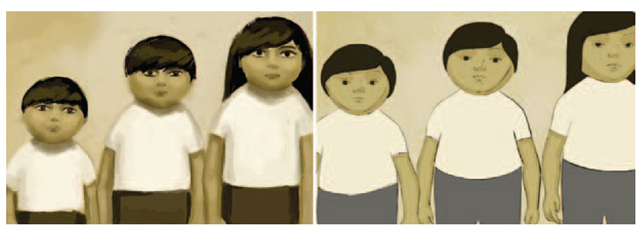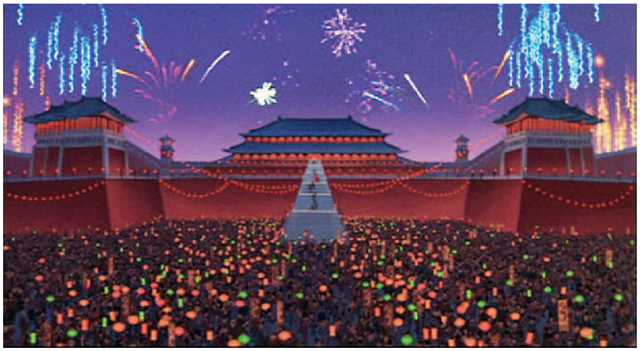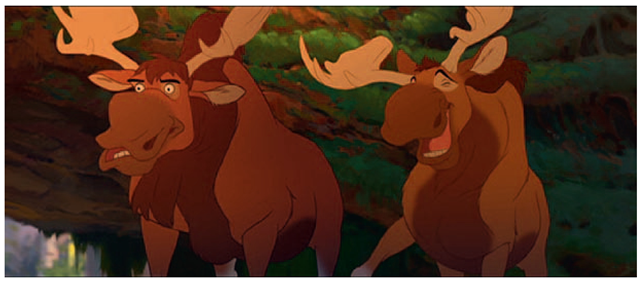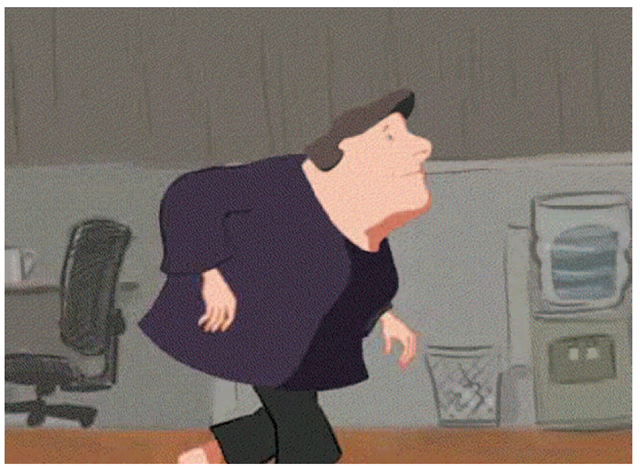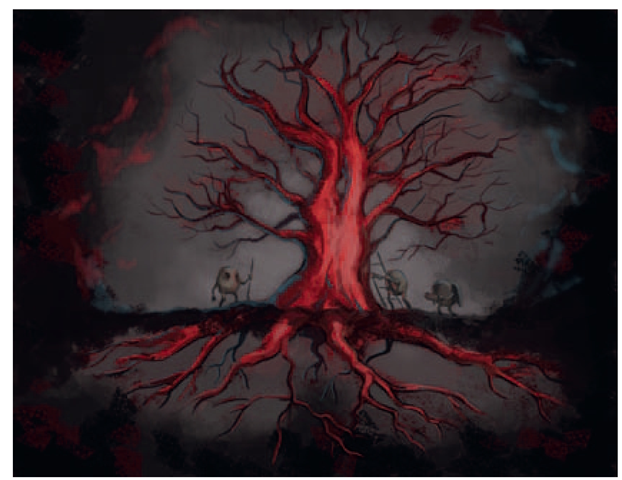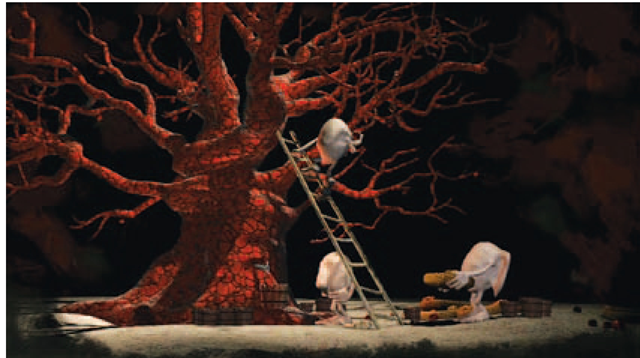Visual Target Not Subject Matter
The visual target or visual style of a film is a large factor in deciding which type of medium will be chosen. It is no longer the subject matter that is the deciding factor. The division between what medium is best for what subject matter has become so blurred as to be nonexistent. 3D software techniques have advanced so that humans, furry animals, and other warm-looking creatures are no longer out of their grasp. The question is, which medium will lend itself best to the artist’s final vision? This question will be answered with strong art direction and experimenting during preproduction.
Let’s look at an example of a visual style. Figure 1.9 is an example of a painterly visual style. It is easiest matched in 2D. Pixar ingeniously incorporated many visual styles, including the UPA style, into its short Your Friend the Rat (2007), included on the Ratatouille DVD release.
FIGURE 1.9 Visual style and frame of final 2D/3D animation
Line Mileage
“Line mileage" is a term that means how much line you have to draw. If you were to take a traditional drawing and stretch out the lines end to end, you would see what your line mileage is. Every millimeter more of pencil or digital line takes more time to draw. Intricate character designs may look good as still images, but the reality of animating such a character is time consuming. A long, curly headed character wearing a wrinkly overcoat, multiple ammo straps over his shoulders, and a striped shirt has extra line mileage. It is difficult to keep so many lines moving well without them seeming to crawl, pop, or distract from the animation.
FIGURE 1.10 Line mileage refers to how much line must be drawn, shown here by stretching out the drawing end to end.
If a traditional medium is chosen and the animation is fully animated, line mileage is looked at very closely and characters are simplified to minimize the line mileage. For example, on the fully animated Disney film Lilo and Stitch, the T-shirt for the character Nani had a coffee cup design on the front. The design was simplified to a heart in order to lower the line mileage. This may not seem like a large simplification, but given that Nani was in much of the movie, the seemingly small simplification (along with many others) added up to less time spent drawing. Anime characters can be designed with more detail because the animation style dictates minimal inbetweening in the characters.
Trench Note
Readers may have noticed that the coffee cup T-shirt appears at the end of the film when Stitch is seen doing the laundry.
A common multiplier of line mileage is crowds. If a traditional animated film calls for crowds of people, that is a ton of line mileage. To simplify the line mileage, many 3D crowd techniques have been used. 3D crowds were rendered to match the 2D line style in Disney’s Hunchback of Notre Dame and with the Hun charge in Mulan. Another method used is to procedurally populate a 3D world with 2D animated sprites; this method was also used in Mulan. The Simpson’s Movie used a similar technique of moving a 3D camera move through a 2D crowd.
FIGURE 1.11 Disney’s Mulan.The palace scene used 2D animation, crowd placement in Maya, 3D fireworks, and compositing software to create this hybrid shot.
3D has successfully been used to animate complex elements that are difficult to animate believably using traditional methods. Objects shown in perspective or having intricate textures and details can become distorted when drawn in 2D. An early example is the magic carpet in Aladdin. The carpet was designed with an intricate texture that needed to bend and move as it animated. The carpet, needing to match a 2D style, was animated in 2D as a template and reanimated and rendered in 3D so that its texture moved believably. In Disney’s Brother Bear, the moose’s antlers proved to be difficult to draw in perspective.
FIGURE 1.12 Broose Johnson and Tony Stanley animated the antlers in 3D to match their 2D moose animation. The 3D animation was then used as a template and redrawn in 2D.
Team Skills versus Production Schedule
A reality is that you might have a team of artists that are not comfortable with the medium you want to use. If you do not have a production schedule that allows for training and retooling for different media, it will ultimately sway the medium choice. Students can relate to this as well. Often they find themselves up against a project deadline and opt for the medium they are most comfortable with instead of experimenting with new media. As a side note, this is a cyclical issue: the medium a student puts on his or her reel is more than likely the medium/industry where that student will find a job. Unless the student is on a project that has the budget and time to allow training in a different medium, he or she may find jobs scarce if a fad shows that animation studios are favoring one medium over another.
Physical Assets and Budget
Having or not having the budget to purchase the physical assets you need for a given medium will certainly sway what your production decisions are. What is the cost of a given medium? Is one less costly than another?
Physical asset costs for the different media, when compared, vary. The diminishing cost of computer animation software has steadily made the software more accessible to the general public; however, 3D studios are costly to set up and even more costly to maintain. Stop-motion or model animation costs are close to that of traditional 2D animation, and traditional animation’s costs can be kept low with homemade light tables and self-punched paper. Just like with any business, physical asset costs can be as little or as much as one wants to spend.
Ultimately, the largest cost is the time spent on the project and the number of artists needed to complete it. Digital processes have tried to address this “time is money" issue. 3D studios, theoretically, can recoup part of their cost by having smaller crews. Paperless or digital 2D animation is slightly cheaper than 2D animation using paper, because the digital process saves time by allowing easy sharing of art assets and bypasses the scanning process.
Once a studio is set up and running in a given medium, adding another medium causes the studio to incur additional costs. For example, the small studio that creates The Simpsons television series (writing, story, and keys) in Los Angeles has small budgets and extremely quick turnarounds. However, the studio also created the larger-budget The Simpsons Movie, which included a large amount of 2D/3D animation. Naturally, after that exposure to 3D the crew began to incorporate 3D more into the television show. If a production has a traditional low-budget pipeline, the producers may be extremely hesitant to take on any different and possibly expensive technique. Such a request can certainly concern the accounting department because of the extra expense.
What is The Main Problem of Combining The Media?
Once a decision has been made to use multiple media, the problems of how to produce the shots loom largely. It is important to work out the following pipeline issues so that the production can be successful:
1. Style matching
2. Registration
3. Frame rate and image format
4. Timing
5. Image sizes
FIGURE 1.13 Pipeline test of 2D character walk cycle with 3D head.
Style matching
During the previsualization stage of production, experimentation will need to take place. Multiple software, drawing methods, combinations of the media, and post-processing effects need to be compared to see which pipeline will most easily achieve the visual style set forth by the art director.
It is important that all experiments be well documented. What workflow was employed to get the artwork from the concept to the final render? Did the final project achieve the desired visual style? At times, a different visual style will be achieved, one not correct for the present project but useful for something in the future. At other times, a method will not work because the technology will not be completely advanced enough yet. Sometimes it only takes half a year for the technology to catch up, and for the next project you will have a half-developed technique that you can reapply and test.
Having a small team of enthusiastic risk takers who are unafraid to experiment with technology and artistic techniques with an eye toward creating stunning visual results is necessary. The techniques found in this topic will help you become one of those enthusiastic risk takers.
FIGURE 1.14 Concept art for Poison Tree, 2008, SCAD, 2D/3D group project.
FIGURE 1.15 Final image from Poison Tree, 2008, SCAD, 2D/3D group project.
